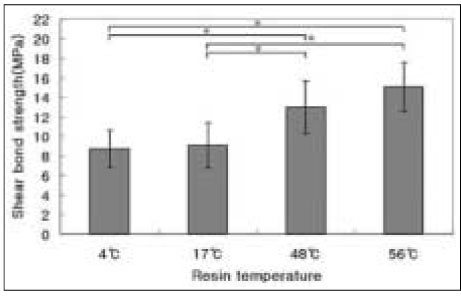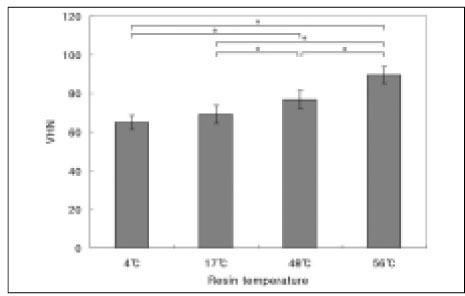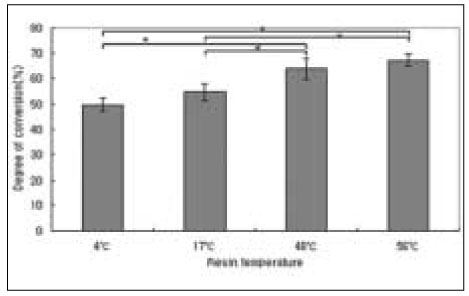J Korean Acad Conserv Dent.
2009 Jan;34(1):30-37. 10.5395/JKACD.2009.34.1.030.
Effect of pre-heating on some physical properties of composite resin
- Affiliations
-
- 1Department of Conservative Dentistry, School of Dentistry, Kyungpook National University, Daegu, Korea. skykim@knu.ac.kr
- KMID: 2176040
- DOI: http://doi.org/10.5395/JKACD.2009.34.1.030
Abstract
- The purpose of this study was to evaluate the effect of pre-heating on some physical properties of composite resin. Eighty extracted, noncarious human molars were used in the present study. Four different temperatures of composite resin were used: 4degrees C, 17degrees C, 48degrees C, and 56degrees C. The 4degrees C and 17degrees C values represented the refrigerator storage temperature and room temperature respectively. For 48degrees C and 56degrees C, composite resin was heated to the temperatures. As physical properties of composite resin, shear bond strength, microhardness, and degree of conversion were measured. The data for each group were subjected to one-way ANOVAs followed by the Tukey's HSD test at 95% confidence level. Both in enamel and dentin, among composite resin of 4degrees C, 17degrees C, 48degrees C, and 56degrees C, the pre-heated composite resin up to 56degrees C revealed the highest shear bond strength, and pre-heated composite resin to the higher temperature revealed higher shear bond strength. Microhardness value was also higher with composite resin of higher temperature. Degree of conversion was also higher with composite resin of the higher temperature. In this study, it seems that pre-heating composite resin up to the higher temperature may show higher shear bond strength, higher microhardness value, and higher degree of conversion. Therefore, when using composite resin in the clinic, preheating the composite resin could be recommended to have enhanced physical properties of it.
Figure
Reference
-
1. Freedman G, Goldstep F. Ultraconservative resin restorations. J Can Dent Assoc. 1999. 65:579–581.2. Cook D, Beech R, Tyas J. Resin-based restorative materials- a review. Aust Dent J. 1984. 29:291–295.3. Asmussen E, Peutzfeldt A. Influence of selected components on crosslink density in polymer structures. Eur J Oral Sci. 2004. 109:282–285.
Article4. Dickens S, Stansburry J, Choi K. Photopolymerization kinetics of methacrylate dental resin. Macromolecules. 2003. 36:6043–6053.
Article5. Ferracane L. Correlation between hardness and degree of conversion during the setting reaction of unfilled dental restorative resins. Dent Mater. 1985. 1:11–14.
Article6. Condon J, Ferracane J. In vitro wear of composite with varied cure, filler level, and filler treatment. J Dent Res. 1997. 76(7):1405–1411.
Article7. Freiberg R, Ferracane J. Evaluation of cure, properties and wear resistance of artglass dental composite. Am J Dent. 1998. 11:214–218.8. Trujillo M, Stansbury W. Thermal effects on composite photopolymerization monitored by real-time NIR. J Dent Res. 2003. 82(special issue A):Abstract 0819.9. Draughn R. Effects of temperature on mechanical properties of composite dental restorative materials. J Biomed mater Res. 1981. 15:489–495.
Article10. Covey A, Tahaney R, Davenport M. Mechanical properties of heat-treated composite restorative materials. J Prosthet Dent. 1992. 68:458–461.11. Ferracane L, Condon R. Post-cure heat treatments for composites: Properties and fractography. Dent Mater. 1992. 8:290–295.
Article12. Asmussen E. Restorative resins: Hardness and strength vs. quantity of remaining double bonds. Scand J Dent Res. 1982. 90:484–489.
Article13. Davidson L, Duysters E, DeLange C. Structural changes in composite surface material after dry polishing. J Oral Rehabil. 1981. 8:431–439.
Article14. de Gee AJ, Pallav P, Werner A, Davidson CL. Annealing as a mechanism of increasing wear resistance of composites. Dent Mater. 1990. 6:266–270.
Article15. Ferracane JL, Greener EH. Fourier transform infrared analysis of degree of polymerization in unfilled resin-Methods comparison. J Dent Res. 1984. 63:1093–1095.
Article16. Cook W, Simon G, Burchill P. Curing kinetics and thermal properties of vinyl ester resins. J Appl Polym Sci. 1997. 64:769–781.
Article17. Daronch M, Rueggerberg F, DeGoes M, Giudici R. Polymerization kinetics of pre-heated composite. J Dent Res. 2006. 85(1):38–43.
Article18. Andrzejewska E. Photopoloymerization kinetics of multifunctional monomers. Prog Polym Sci. 2001. 26:605–665.19. Nicholls J. Polymerization shrinkage of densely-filled resin composite. Oper Dent. 2001. 26(5):498–504.20. Kim KO. Microleakage at the cervical margin of class II composite restorations with different intermediate layer treatments. J Korean Acad Conserv Dent. 2003. 28:467–474.
Article21. Holmes R, Ruerggeberg F. Composite film thickness at various temperatures. J Dent Res. 2004. 83:(Abstract No. 3265).22. Freedman G, Leinfelder K. Seventh-generation adhesive system. Dent Today. 2002. 21:106–111.23. Bortolotto T, Krejci I. The effect of temperature on hardness of a light-curing composite. J Dent Res. 2003. 82(special issue):Abstract 0119.24. Walker M, Reem Haj-Ali, Williams K. Influence of environmental condition on dental composite flexural properties. Dent Mater. 2006. 22:1002–1007.
Article25. Daronch M, Rueggerberg F, DeGoes M. Monomer conversion of pre-heated composite. J Dent Res. 2005. 84(7):663–667.
Article26. Opdam J, Roeters J, Joosten M, Veeke O. Porosities and voids in class I restorations placed by six operators using a packable or syringable composite. Dent Mater. 2002. 18:58–63.
Article27. Bagis H, Rueggerberg F. Effect of post-cure temperature and heat duration on monomer conversion of photo-activated dental resin composite. Dent Mater. 1997. 13:228–232.
Article28. Sideridou I, Tserki V. Effect of chemical structure on degree of conversion on light-cured dimethacrylate-based dental resins. Biomaterials. 2002. 23:1819–1829.
Article29. Chung JH, Roh BD. In vitro micro-shear bond strength of five composite resins to dentin with five different dentin adhesives. J Korean Acad Conserv Dent. 2004. 29:353–364.
Article30. Han SH, Kim ES, Cho YG. Enamel adhesion of lightand chemical cured composites coupled by two step self-etch adhesives. J Korean Acad Conserv Dent. 2007. 32:169–179.
Article31. Sun Y, Zhang Z, Wong CP. Study on mono-dispersed nano-sized silica by surface modification for underfill application. J Colloid interface Sci. 2005. 292:436–444.
Article32. Taira M, Khan M, Ohmoto K. Curing performances of four experimental Bis-GMA based binary monomer mixtures for dental visible-light cured composite resin inlays. J Mater Sci Lett. 1994. 13:1229–1231.
Article33. Kurachi C, Tuboy A, Magalhaes S. Hardness evaluation of a dental composite polymerized with experimental LED-based devices. Dent Mater. 2001. 17:309–315.
Article
- Full Text Links
- Actions
-
Cited
- CITED
-
- Close
- Share
- Similar articles
-
- Development of anticariogenic composite resin
- Inhibitory effect on Streptococcus mutans and mechanical properties of the chitosan containing composite resin
- The effect of bonding resin on bond strength of dual-cure resin cements
- Effect of solution temperature on the mechanical properties of dual-cure resin cements
- Physical properties of different self-adhesive resin cements and their shear bond strength on lithium disilicate ceramic and dentin





